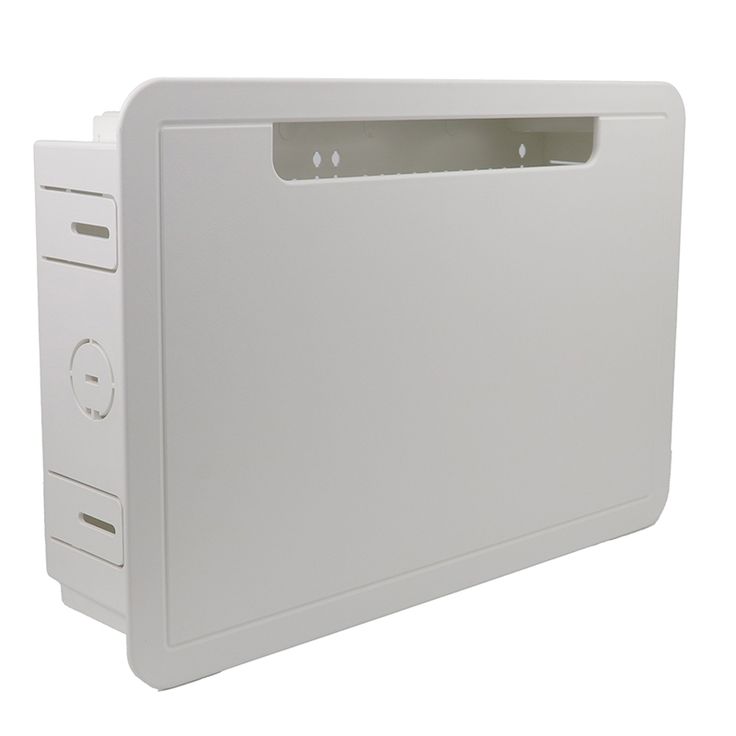Imagine the following: your living room has become a smooth, modern room with all cords hidden, with the emphasis made only on your beautiful TV. A TV recessed wall box would make that possible. This extra gadget can make things look good as well as simplifying the process of cabling to achieve a clutter-free appearance.
As a movie lover or a game player, you have to select the appropriate TV recessed wall box that can greatly influence your viewing experience. Having different alternatives, one should know what makes them different and how to choose the best one, depending on his or her needs.
We are going to get into all that you need to know about choosing the ideal TV recessed wall box!
The importance of a TV recessed wall box
A tv recessed wall box is not just an effective accessory, but it is an essential part of any entertainment system at the home. It lets you mount the television flat against the wall to complete a smooth appearance that is aesthetically pleasing to your room.
Cable management is one of the greatest benefits. These wall boxes give you a tidy area to hide the wires and cables, lessening the clutter in your area, and making it look cleaner. Nobody would like to have messy ropes sticking out in front of everyone.
Also, the safety is an important factor. Recessed wall box A recessed wall box can assist in avoiding accidental pulling or tripping the loose wall cable falling to the floor. It makes sure that everything is well packed away and yet easy to access in times of need.
In addition, installing this kind of installation would open up space otherwise used by other things such as decorations or gaming consoles and create a more flexible living area.
Types of TV recessed wall boxes
Variety is of primary importance when it comes to TV recessed wall boxes. They can be single-gang and double-gang wall boxes. Single-gang installations are best suited to simple installations, which only support a single cable outlet.
More versatility is provided in the models that are double-gang, which offer space to make several connections. These work very well with elaborate home theater systems having many devices.
Certain recessed wall boxes have in-built power outlets. This makes it less cluttered and convenient, as you are able to plug the TV or other associated devices behind the screen.
The other one is the low voltage box that is tailored to audio/video cables. They are able to keep a clean appearance and in the meantime they are needed to keep optimum performance without being interfered with by electrical wiring.
Bear in mind reconfigurable units enabling you to modify your configuration on a basis of necessity. This adaptability can be priceless with the changes in technology with time.
Factors to consider when choosing the right TV recessed wall box
In choosing the TV recessed wall box size is the key. Make sure that it fits your television size and the room you have on your wall.
Take a look at the wall box material. Better quality products can be more durable and heat-resistant and thus have a longer lifespan.
Search cable management options, too. Certain boxes have inbuilt channels or clips to allow cables to be arranged and without being seen.
Also compatibility; ensure that it matches with some mounting systems or brackets that you intend to use.
Not to be forgotten safety standards. Choose a product that complies with electrical standards in your region in order to have a safe working product in the long term.
Think about aesthetics. A good wall box must be concealed in your decor and at the same time be useful.
Installation process and tools needed
Recessed wall box installation of TV can be a daunting feat to undertake, yet it is not something you cannot do with the proper mindset. This will require a stud finder, a level, a drill, a screwdriver, and a measuring tape, all of which are essential to start with.
To start with, identify the studs on your wall with the help of a stud finder. This provides you with a safe point of installation of your box. Mark with the use of the measuring tape where you will stick your TV and make all the measurements right.
Then trace out a hole based on the size of the wall box you have selected. Always be accurate by taking in the instructions of the manufacturer.
Install a wall box in this opening by screwing it into the box as in the kit. It is also essential that it should be plastered on the wall surface to ensure that there are no cracks after completion.
Make all the required cables and pass them through and seal up with dry wall or paint accordingly. Every step is important both to be safe and to look good!
Tips for maintaining and organizing cables
Organizing your cables can make any entertainment area look better. Begin by tying up the cords with cable ties or Velcro. This is an easy action to take, and it avoids getting tangled and gives a more clean appearance.
Another useful method is labelling. Label each cable with a small adhesive label allotting the purpose of the cable which will be easier to identify in the future.
It is worth considering cable management sleeves or the raceways to have a more refined look. These do not only cover the wires, but also safeguard them against wear and tear.
Check your cables periodically, to see whether they are frayed or broken. You can save yourself against risks in the future by getting early warning.
Consistently consider in advance the addition of new devices. You should assign certain space to future cables during installation to ensure your organization system is not destroyed as technology advances.
Cost comparison of different TV recessed wall boxes
Cost might differ greatly in terms of the brand, features and materials in case of selecting a TV recessed wall box. Simple models cost between 15 and 30 dollars. They are usually adequate to install in a mainstream setting but can not include such advanced systems as a cable handling system or even include an inbuilt power socket.
The mid-range ones are typically between 30 to 70. They tend to have superior quality of building, enhanced cable management options and in certain cases provide additional accessories that can make it easier to install.
To get high-end ones, you will have to spend between 70, and more than 150. Other features that may be added to these models include HDMI ports mounted directly on the wall plate or built in surge protection.
You should evaluate what you need to make a choice. A cheaper alternative can be used in casual viewing environments and products of a higher quality in the home theater market can fit high-end consumers who desire smooth design and functionality.
A balance of features and price will lead you in the right direction in selecting the appropriate option in designing the organized area around your entertainment system.
















